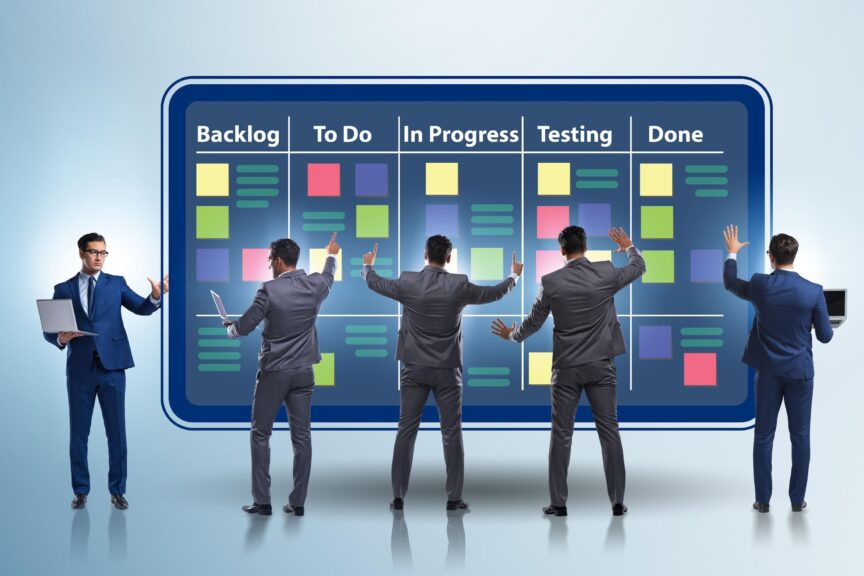
Agile methodologies have revolutionized the way businesses approach project management and software development. The principles of Agile, which prioritize adaptability, collaboration, and iterative development, have become the cornerstone of modern project management.
As organizations seek to scale Agile practices to larger teams and more complex projects, they often turn to frameworks such as SAFe (Scaled Agile Framework) and LeSS (Large-Scale Scrum). These two methodologies offer distinct approaches to scaling Agile principles, catering to different organizational needs and project requirements.
In this article, we will delve into the intricacies of SAFe and LeSS, examining their pros and cons and discussing when each methodology might be the preferred choice for implementation.
SAFe’s Symphony: Orchestrating Large Teams
SAFe is designed to address the challenges of scaling Agile to larger enterprises and complex projects. Its structured framework provides a comprehensive set of practices, principles, and roles that enable organizations to coordinate and synchronize the delivery of large-scale systems.
SAFe’s emphasis on alignment, collaboration, and transparency makes it particularly well-suited for organizations with extensive teams and intricate interdependencies. By orchestrating large teams and aligning them towards a common goal, SAFe aims to streamline the development and delivery of complex solutions.
However, the rigidity of SAFe’s framework may introduce overhead and bureaucracy, impacting the agility and autonomy of individual teams.

LeSS’s Lure: Keeping It Small and Simple
In contrast to SAFe, LeSS takes a minimalist approach to scaling Agile, focusing on simplicity and decentralization. LeSS advocates for reducing complexity by keeping teams small and enabling them to work together as a cohesive unit.
By promoting a culture of self-management and cross-functional collaboration, LeSS aims to eliminate unnecessary processes and overhead, allowing teams to focus on delivering value. This approach makes LeSS ideal for organizations that value flexibility, adaptability, and empowerment at the team level.
However, the decentralized nature of LeSS may pose challenges in aligning multiple teams toward a unified direction, especially in complex enterprise environments.
The Duel: SAFe vs. LeSS in Different Scenarios
When considering whether to implement SAFe or LeSS, organizations must assess their specific needs and project characteristics.
For large enterprises with extensive teams, intricate dependencies, and a need for centralized coordination, SAFe may offer a more structured and prescriptive approach. On the other hand, organizations prioritizing agility, autonomy, and decentralized decision-making may find LeSS a more suitable fit, especially in environments where simplicity and flexibility are paramount.
It’s essential to evaluate the trade-offs between centralized control and decentralized empowerment when selecting the appropriate methodology for scaling Agile.

From Theory to Practice: Real-World Implementations
SAFe and LeSS have been implemented in various organizations across different industries, each showcasing unique success stories and challenges. Real-world implementations of SAFe have demonstrated significant improvements in alignment, collaboration, and delivery predictability, particularly in large enterprises with complex product development cycles. Conversely, organizations that have adopted LeSS have reported enhanced flexibility, team empowerment, and faster decision-making, especially in environments where adaptability and customer-centricity are crucial. Understanding these real-world implementations can provide valuable insights into the practical implications of choosing SAFe or LeSS for scaling Agile.

For a leading airline company delivering over 4,000 flights daily to more than 250 destinations, Pointwest re-platformed and enhanced its legacy system for Airport Customer Service Agents. The goal was to modernize the system that was written using an open-source software development framework that is no longer supported.
Pointwest has been implementing the Agile framework for various solutions implementation. For this client though, it was their first time to apply Agile methods in its software delivery. We wanted to promote transparency and keep the approach simple for all stakeholders by starting with small changes, and continuously inspecting, adapting, and adjusting, gradually increasing feature additions in subsequent iterations.
With eight (8) scrum teams across three (3) different countries and time zones, over a 2-year re-platforming journey, the direction was centralized at the business portfolio level driven by a shared vision and business priority. A Program Increment (PI) planning identified high-value features and priorities, defined objectives, and assessed dependencies and risks. Within a Program Increment, the entire system was planned and validated, then broken down into a series of iterations. A single Program Increment planning session entailed a two-day workshop to create a roadmap for the next six (6) sprints together with the stakeholders, product owners, business analysts, technical architects, and Scrum teams.
The project team adopted test automation and CI/CD practices, to further streamline testing, release builds, and deployment processes, to match the pace of the development.

The decision to implement SAFe or LeSS should be guided by a thorough assessment of an organization’s size, project complexity, and enterprise needs. While SAFe offers a structured approach to orchestrating large teams and complex dependencies, it may introduce bureaucratic overhead. On the other hand, LeSS prioritizes simplicity and decentralization, promoting team autonomy but potentially posing challenges in aligning multiple teams.
By carefully evaluating the pros and cons of each methodology and considering real-world implementations, organizations can strategically select the most suitable approach to scaling Agile, aligning it with their unique organizational goals and project requirements.
For more than two decades, Pointwest has been partnering with some of the world’s largest and most recognized companies to bridge the gap between today’s challenges and future possibilities through practical, tailored solutions that deliver transformation with speed and accuracy. Connect with us at [email protected] to learn more about how Pointwest can help you chart your course.




